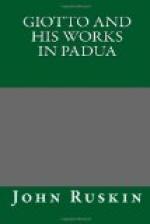* * * * *
XXXII.
THE SCOURGING OF CHRIST.
It is characteristic of Giotto’s rational and human view of all subjects admitting such aspect, that he has insisted here chiefly on the dejection and humiliation of Christ, making no attempt to suggest to the spectator any other divinity than that of patience made perfect through suffering. Angelico’s conception of the same subject is higher and more mystical. He takes the moment when Christ is blindfolded, and exaggerates almost into monstrosity the vileness of feature and bitterness of sneer in the questioners, “Prophesy unto us, who is he that smote thee;” but the bearing of the person of Christ is entirely calm and unmoved; and his eyes, open, are seen through the binding veil, indicating the ceaseless omniscience.
This mystical rendering is, again, rejected by the later realistic painters; but while the earlier designers, with Giotto at their head, dwelt chiefly on the humiliation and the mockery, later painters dwelt on the physical pain. In Titian’s great picture of this subject in the Louvre, one of the executioners is thrusting the thorn-crown down upon the brow with his rod, and the action of Christ is that of a person suffering extreme physical agony.
No representations of the scene exist, to my knowledge, in which the mockery is either sustained with indifference, or rebuked by any stern or appealing expression of feature; yet one of these two forms of endurance would appear, to a modern habit of thought, the most natural and probable.
* * * * *
XXXIII.
CHRIST BEARING HIS CROSS.
This design is one of great nobleness and solemnity in the isolation of the principal figure, and removal of all motives of interest depending on accessories, or merely temporary incidents. Even the Virgin and her attendant women are kept in the background; all appeal for sympathy through physical suffering is disdained. Christ is not represented as borne down by the weight of the Cross, nor as urged forward by the impatience of the executioners. The thing to be shown,—the unspeakable mystery,—is the simple fact, the Bearing of the Cross by the Redeemer. It would be vain to compare the respective merits or value of a design thus treated, and of one like Veronese’s of this same subject, in which every essential accessory and probable incident is completely conceived. The abstract and symbolical suggestion will always appeal to one order of minds, the dramatic completeness to another. Unquestionably, the last is the greater achievement of intellect, but the manner and habit of thought are perhaps loftier in Giotto. Veronese leads us to perceive the reality of the act, and Giotto to understand its intention.
* * * * *




